Animals of the Savanna
The savanna ist the best place to go to safari, because there you find the most fascination wild life of Africa. Savannas are intermediate between a grassland and a forest. Typical for savannas is an open grassland with scattered trees. This grass provides food for the hundreds of species that live in the African savanna. Typical trees are the umbrella acacia and the baobab.
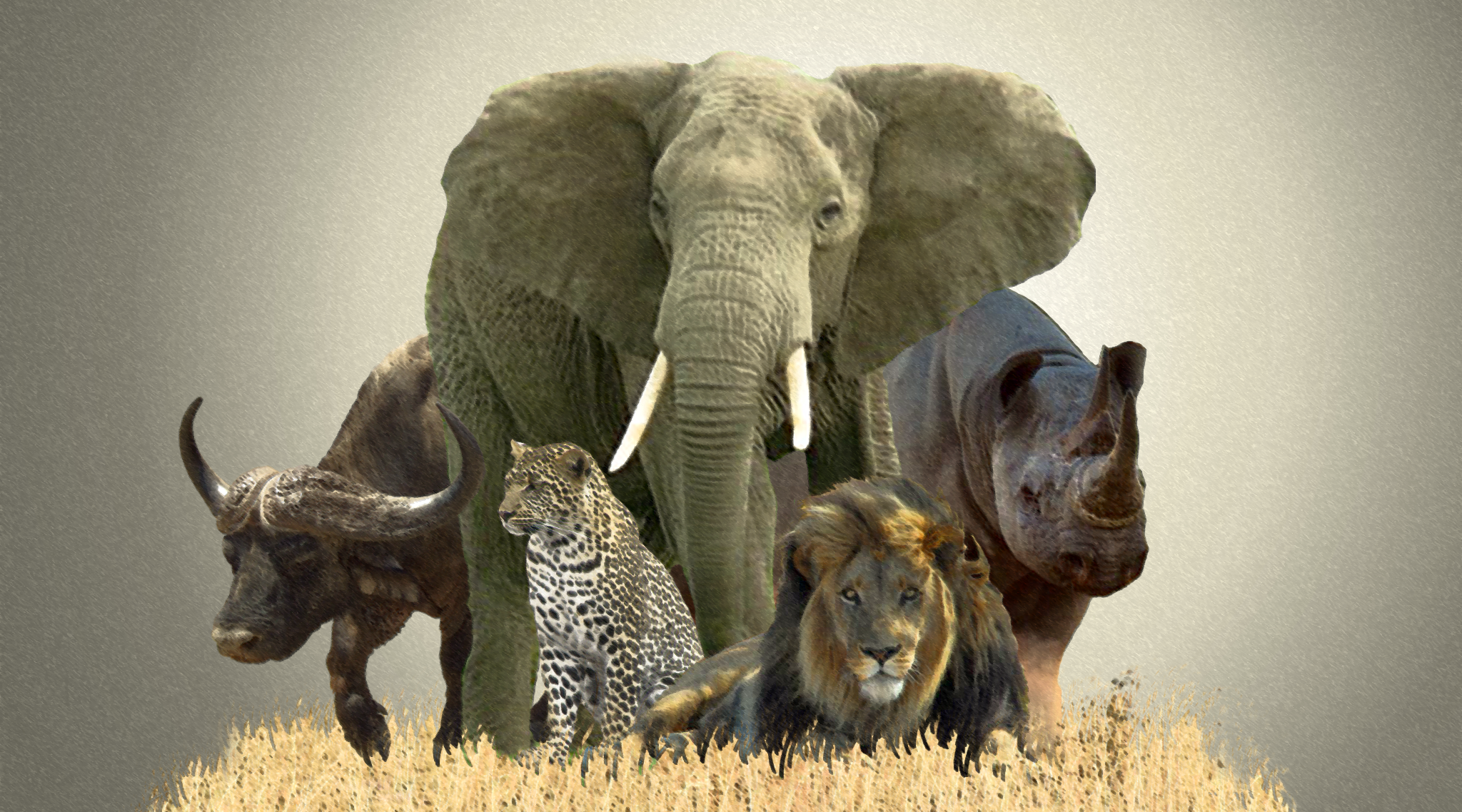
Savannas have a long dry season, and are swept by wildfires. There is also a rainy season, during which tall grasses grow, providing food for zebras, wildebeest and antelopes. Many savanna animals migrate to deal with this problem such as wildbeest, antelopes or zebras. The grazers are hunted by fearsome predators such as lions, leopards and cheetahs.
Zebras, Elefants and more

Zebras are the wild horses of Africa. They are common in East and Southern Africa. No two zebras have exactly the same stripe pattern. They are as unique as our fingerprints. Zebras are grazers. They prefer the open planes so that they can spot their enemies from afar. They gather in huge migratory herds. The male gathers his own group of femals around him and fiercly guards them from rivals. Fights between stallions can be heard a long way off. Sometimes zebras mix with herds of wildebeest. The two species eat different types of grass, so they do not compete for food. Both need plenty of water und will travel long distances to get it. Zebras are one of the lion's favorite prey animal.
Teamwork: Sometimes animals work togehter. This is the case with zebras and the oxpecker. Oxpeckers are small birds that travel with zebra herds. They eat bugs off zebras. Zebras know to run when oxpeckers fly up. It's a warnung that predators are coming.
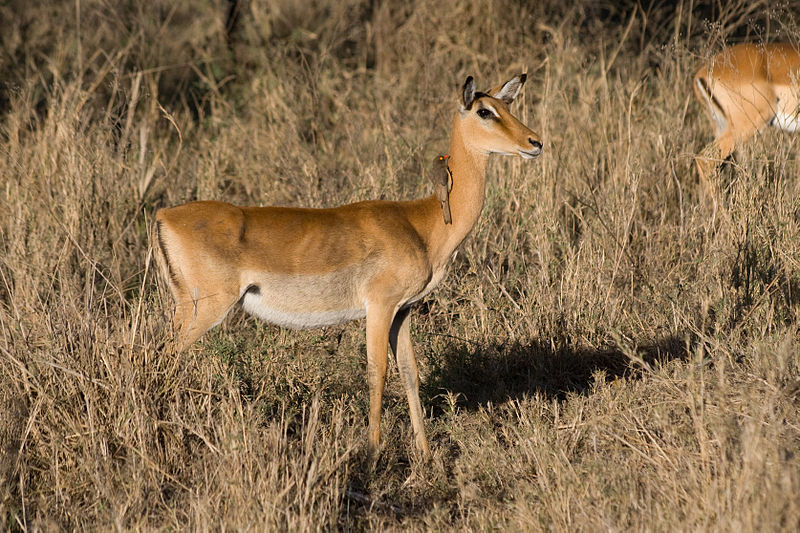 Antelopes
Antelopes
Africa is home to more than 90 kinds of antelopes. Some live in the desert, some in the bushland, there is even a small species, that raoms the tropical forests. Impalas live in the savannas in large herds of about 100. They run fast und jump high to escape from enemies. Gazelles graze early in the morning. They get water from the plants they eat. An imposant antelope is the kudu. These rather shy browsers are found in well-bushed savannas. They remain motionless for long periods of time when feeling threatened. Kudu bulls have long, spiral horns. As with most antelope species, females are hornless and smaller in size. With their large ears they can hear extremley well and are prepared to hop off if a predator.
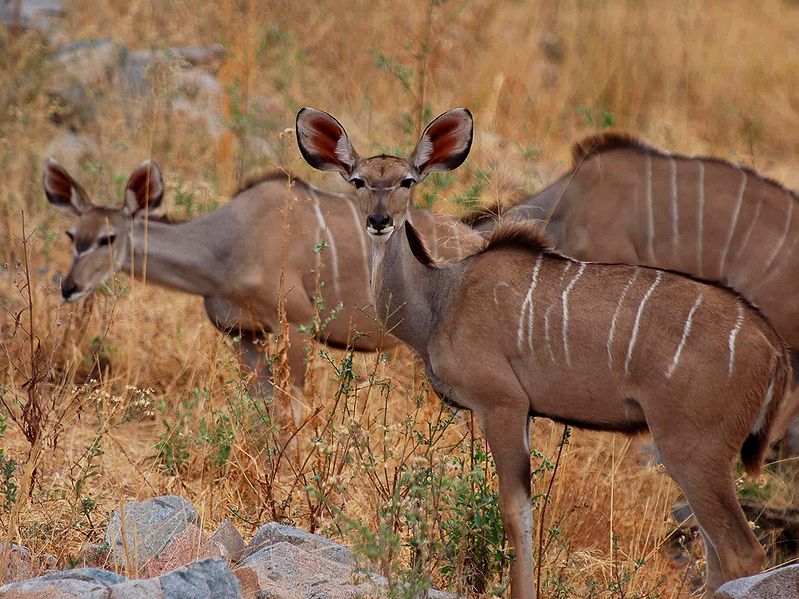 An imposant antelope is the kudu. These rather shy browsers are found in well-bushed savannas. They remain motionless for long periods of time when feeling threatened. Kudu bulls have long, spiral horns. As with most antelope species, females are hornless and smaller in size. With their large ears they can hear extremley well and are prepared to hop off if a predator.
An imposant antelope is the kudu. These rather shy browsers are found in well-bushed savannas. They remain motionless for long periods of time when feeling threatened. Kudu bulls have long, spiral horns. As with most antelope species, females are hornless and smaller in size. With their large ears they can hear extremley well and are prepared to hop off if a predator.

Buffalos
African buffalos live in herds. They are found throughout the northern and southern savanna as well as the lowland rain forest. Herds occupy a stable home range. 18 hours per day they spend moving, always making sure to be close to water. African are very intelligent and courageous. If undisturbed, buffalo are docile. If threatened however, they become fearsome adversaries, despite their poor sight. Herds will stick together and charge as a unit when threatened. Predators such as lions and crocodils have difficulty preying on even young and feeble animals. Oxpeckers are birds which frequently accompany buffalo, eating biting insects from the buffalo's skin.

Elephants
Elephants are the largest land mammal on earth. You will be in awe if you are on safari and an elephant is crossing your way. Females and their calves gather in family groups. When the young bulls are old enough to look after themselves, they leave the family. Female elephants stay together as long as they live. Elephants communicate with sounds, gestures and touching. They hear much better than we do, they can hear sounds on the ultrasonic level. And much more amazing: they can "hear" with their feet. They can hear the calls of each other up to 10 kilometers away. Elephants have an excellent memory. Since generations they are roaming the same ways. They often visit the same places year after year. At night they travel great distances, spending much of their time feeding. Elephants dig deep holes in dry river beds, waiting hours and hours for the water. This is useful to other animals, which use the holes after the elephants. The elephant's trunk is a marvelous tool used for feeding, drinking, smelling, and embracing.
Animals living in groups
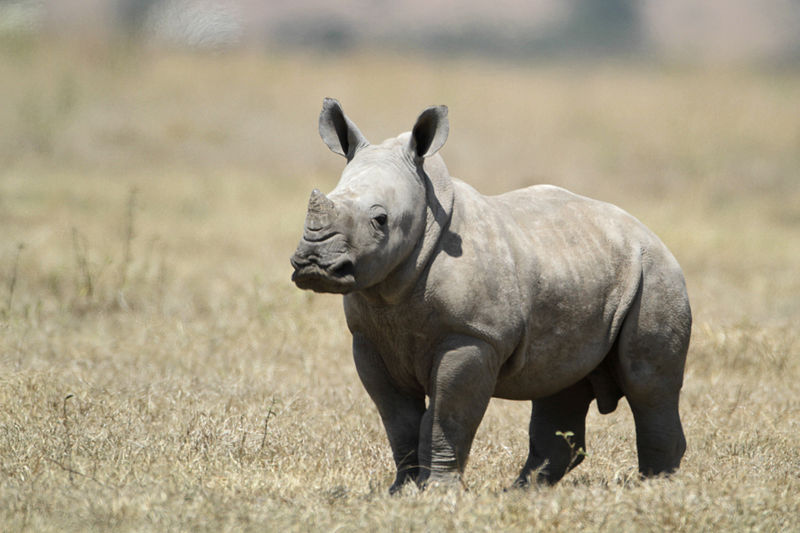 Rhinos
Rhinos
Rhinos live in the southern part of Africa. Females live in small groups, accompanied by a dominant bull. The rhino bull is very territorial. Its home range always indcludes at least one waterhole, preferable with a mudwallow. They love to take a mud bath. The male marks its territory with dung-heaps and forms with its hind legs a flattened patch, sometimes more than two meters across. There are two kinds of rhinos in Africa, the black rhino and the white rhino. It is not the colour that makes the difference but their lips. The white rhino graze on grass, the black rhino graze twigs and leaves. The black rhinos are very rare. They have been drastically reduced by poaching. The reason is the rising demand of rhino horn. Why? Some people believe, that rhino horn is good for increasing their energy. But indeed the horn exists of nothing but hair fused into a hard bone-like substance. Only every three years a rhino gets a baby rhino. So you can imagine how hard it is to help them survive in the wild.
 Giraffe
Giraffe
leben in Gruppen von 10 bis 20 Tieren. Gerne mischen sie sich unter Gnus und Zebras, um besser geschützt zu sein. Giraffen sind sehr friedfertig und kümmern sich rührend um ihren Nachwuchs. Die Weibchen organisieren einen Kindergarten. Während eine auf alle Jungen aufpaßt, können die übrigen auf Nahrungssuche gehen. Dank ihrer langen Beine erreichen sie eine Geschwindigkeit von 50 km oder mehr. Sie ernähren sich von Pflanzen. Mit ihrem langen Hals erreichen sie selbst die zartesten Blätter auf den Akazienbäumen. Die spitzen Stacheln der Akazien können ihnen nichts anhaben, denn ihre Schnauze ist durchlässig wie ein Schwamm. Mit Schnarchtönen melden sie eine drohende Gefahr.
Schon gewußt? Obwohl Giraffen einen so langen Hals haben, besitzen sie nicht mehr Halswirbel wie wir Menschen.

Hippo
Hippos can be found in lakes and rivers throughout the southern part of the Africac continent. They are massive with large heads, small ears and periscope eyes. They are no beauties, but characters. They are gathering in groups up to hundred members during the dry season. They are very sociable, and the mothers care lovingly for their young. Most of their time they spend in water, wallowing together in backwaters. At night they leave the water to graze. They travel far distances. If alarmed, they will bolt straight back to the water, scattering everthing in their path. So be careful, that you don't get between them and the water!
Predators of the savanna
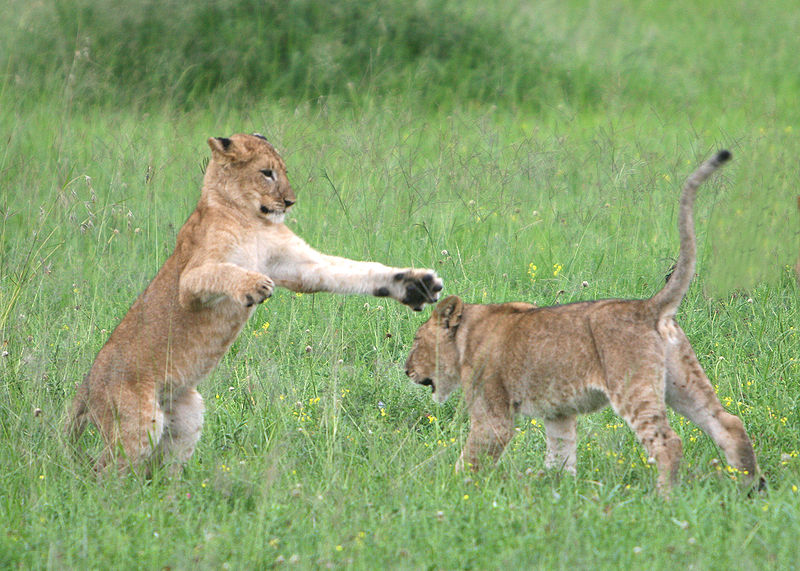 Lions
Lions
Lions are the kings of the savanna. To see a lion in the buschland is one of the reasons of going on safari. Almost always you will see a lion or lioness snoozing, because they rest most of the day, at least 20 hours. Lions are the only kind of cat, that live in groups, called prides. A pride is made up of females and their young, and one fully-grown male lion, the pride leader. Prides combine to hunt. They are very intelligent und highly cooperative. They are seldom dangerous, particularly by day. However, they are aggressive, and when nervous their moods can change quickly. So be aware on safari, when a lion crosses your way. Lions must learn quite a lot until they are grown up. They have to learn the ways of the bush, they must learn how to hunt, and also they must train to roar.
 Leopard
Leopard
Leopards live in grasslands, forests, mountains and even semi-desert. They are cats like lions, but they tend to be solitary. Leopards are not easy to observe, because most of the day they are hidden in trees or among rocks. They use trees as platform and for protection. Their way of hunting is very cat-like. They lie silently on a tree branch above a game trail and then drop on to the back of the victim. They hide their prey up the tree. Like real cats they can extract and retract their claws. Leopards eat nearly everything that moves. Their favorite meal: baboons. Leopards are shy and nocturnal.
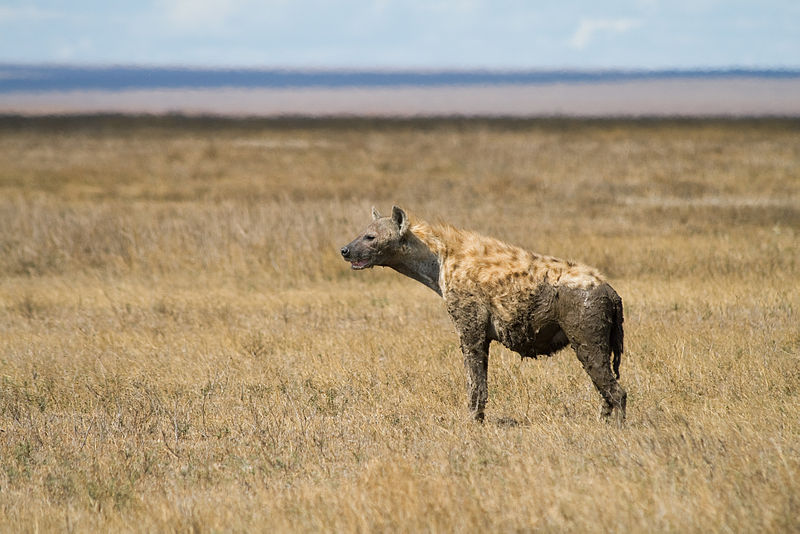 Hyena
Hyena
Hyenas live in savannas and semi-deserts. The head in proportion to its body is pretty big, it has big, round ears, a sloping back and a short bushy tail. They live in familiy clans. Because of their gruesome habits and unnerving cries they figure in superstitious beliefs of African tribes. They are very clever animals with excellent sight, smell and hearing. Hyenas and vultures are often seen together in the savanna. The clever hyenas watch for vultures in the sky circling over a kill and use them as guides. Hyenas and lions are sometimes fighting for the prey. A clan of hyenas may even be brave enough to chase a pride of lions off their kill. When hyenas are mating the make the most terrible concert, often in moonlight. Female hyenas retire to sheltered places, when they become their babys. Usually up to four pups are born. The females remain within the family clan, the males leave the clan at the age of two.
Best friends forever?

The Nil croco and hippo live in the same habitat. Sometimes they become friends. The older crocos are the more they become agressive. They even start to attack young hippos. The two on the left photo have fun with each other. But will they stay friends forever? Probably not.
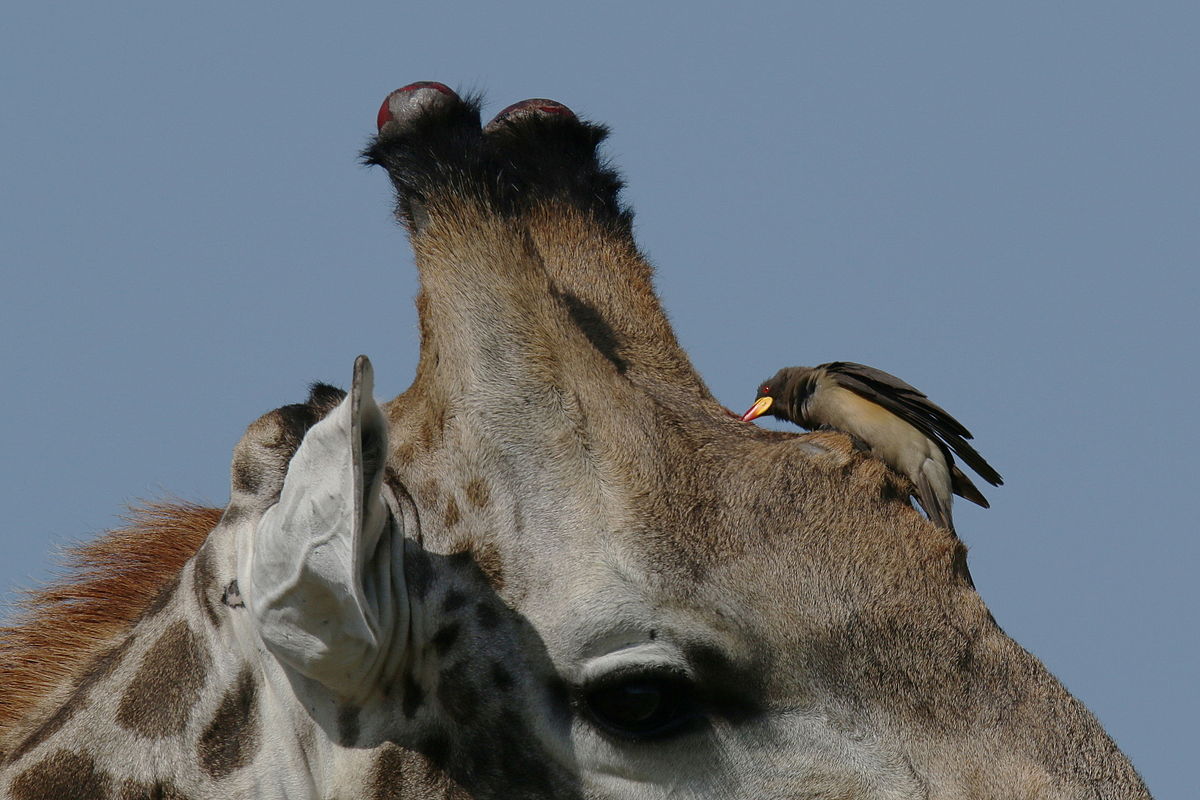 Bis dass der Tod uns scheidet, könnte dieser bunte Madenhacker zu der Giraffe sagen. Er lebt in der Savanne und bildet eine langjährige Wirtsgemeinschaft mit großen Wildtieren. Er ist gesellig aber auch gefräßig. In Gruppen begleitet er sein Wirtstier, und ernährt sich von Insekten und Würmern, die er aus Fell und Ohren pickt. So füllt er seinen Bauch, während er seinen großen Freund von lästigen Parasiten befreit. Madenhacker sind deshalb willkommene Begleiter von Giraffen, Antiopen, Flusspferden, Büffeln und Nashörnern. Das beste an dem Madenhacker ist, dass er seine Wirte vor den größten Räubern der Savanne warnt wie Löwen, Leoparden und Hyänen. So hält er seinen Freund am Leben und hat immer einen gedeckten Tisch.
Bis dass der Tod uns scheidet, könnte dieser bunte Madenhacker zu der Giraffe sagen. Er lebt in der Savanne und bildet eine langjährige Wirtsgemeinschaft mit großen Wildtieren. Er ist gesellig aber auch gefräßig. In Gruppen begleitet er sein Wirtstier, und ernährt sich von Insekten und Würmern, die er aus Fell und Ohren pickt. So füllt er seinen Bauch, während er seinen großen Freund von lästigen Parasiten befreit. Madenhacker sind deshalb willkommene Begleiter von Giraffen, Antiopen, Flusspferden, Büffeln und Nashörnern. Das beste an dem Madenhacker ist, dass er seine Wirte vor den größten Räubern der Savanne warnt wie Löwen, Leoparden und Hyänen. So hält er seinen Freund am Leben und hat immer einen gedeckten Tisch.
Birds in the savanna
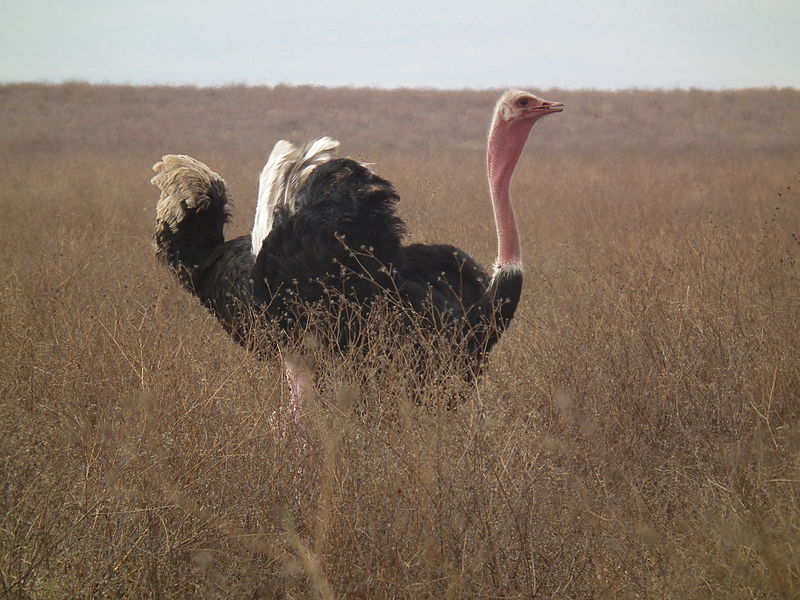
The ostrich is the largest bird on earth. It is found in the drier areas of Africa. Ostriches cannot fly but they run very fast, up to 70 kilometers per hour. The adults use their use their powerful legs not only to run fast to escape enemies, but as weapons, to keep attackers at bay. They live in small, scattered groups. They mate for life, and they share the task of incubating the eggs. The male, which has mostly black feathers, sits on the eggs at night. The female, which has brown feathers, covers them during the day. In this way, the nest is much harder to see. Once the young hatch, the male looks after the chicks until they are old enough to fend for themselves.

White-backed vulture
Vultures are magnificent birds that find and eat dead animals. They fulfill a vital function in the ecosystem of the savanna. The scavengers do the dirty work of cleaning up after death. They can strip a zebra carcass clean in minutes. The White-backed Vulture is a medium sized bird. It has a wingspan of 1.2 – 1.7 metres. In treetops, they make stick nests as big as king-size beds. As its name suggests, the back of this Vulture is white in colour which contrasts with its dark plumage. Vultures have muscular legs, sharp talons and sharp bills. The African White-backed Vulture lacks neck feathers which prevents it from becoming soiled when dipping into a carcass. Vultures have incredible eyesight which enables them to spot their prey while soaring through the sky. A Vulture can spot a large animal carcass from around 8 kilometers away on savanna plains. They also have a very well developed sense of smell which helps them to find their food.
Der Nacktmull
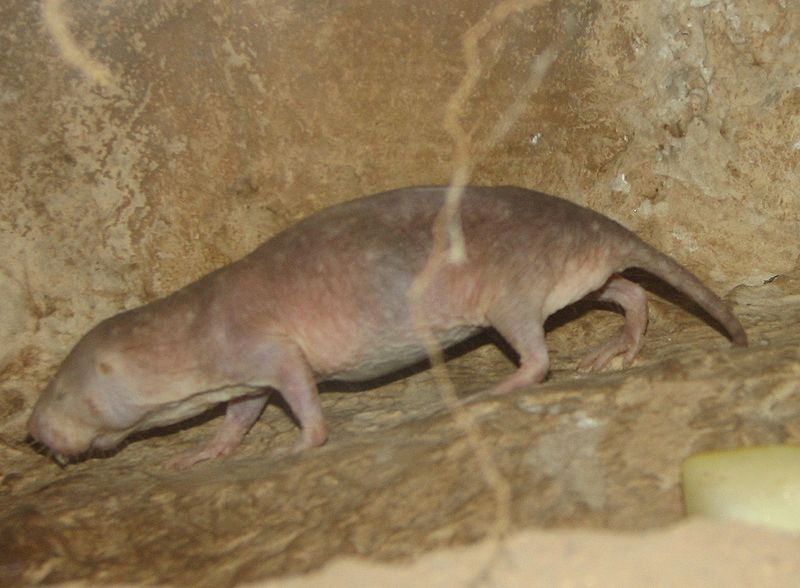
Der Nacktmull gewinnt sicher keinen Schönheitspreis, aber er ist ein echter Tiefbau-Spezialist. Nacktmulle haben sich an das Leben unter der Erde angepaßt, so überleben sie auch, wenn mehrere Jahre hintereinander kein Regen fällt. Sie brauchen nämlich kein Wasser, das beziehen sie aus ihrer Nahrung: Spinnen, Käfer, Würmer. Der Nacktmull lebt in Kolonien, die Arbeiterinnen schaffen unter der Erde ein weitverzweigtes Reich. Das Reich wird an den Ausgängen von "Soldaten" bewacht, um Feinde am Eindringen zu hindern. Über die Jahrtausende haben Nacktmulle ihr Fell verloren und ihr Augenlicht. Sie werden von einer Königin regiert, die allein fähig ist, Nachkommen zu zeugen. Sie ist ziemlich aggressiv und bekämpft selbst ihre direkten Nachkommen. Sie erreicht für Nacktmulle ein biblisches Alter von 13 Jahren. Ihre Arbeiterinnen sind dagegen unfruchtbar und werden nur etwa fünf Jahre alt.
Termits - the blind architects of the savanna
If you think that we are the most potent architects on earth then you are wrong. It is the termit. The insect has no eyes und builds its homes withtout technical devices or computers. It only relays on vibrations and smell. Termite hills are an artwork of 6 - 8 meters hight, with air-conditioning and ventilation. Termits are as small as a grain of rice. They are social insects that live in colonies with 2 - 3 million termits. They raise their young as a group. Termits are living of mushrooms which they breed in their hills. Termites are among the most successful groups of insects in Africa. While they are building their home, they recycle wood and plant matter. This is why they contribute a lot to the ecological system of the savanna.
Hier siehst du einen Film über eine Safari durch die Naturschutzparks von Tansania
Über viele Tiere der Savanne wissen afrikanische Völker witzige oder seltsame Märchen zu erzählen. Bei Hörbücher kannst du einige Märchen hören oder unter Märchen auch lesen.

